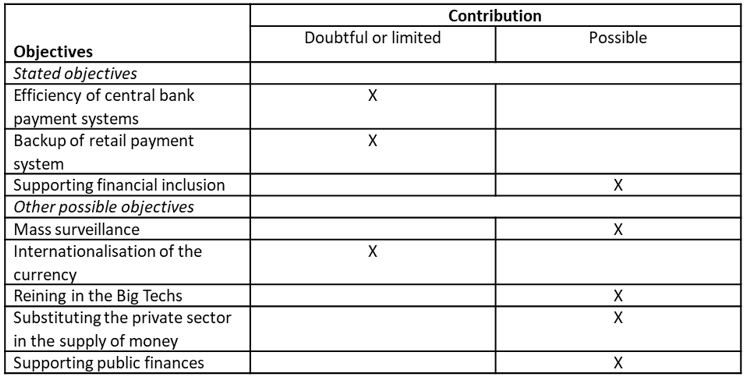References
Bank for International Settlements (2022), CBDCs in emerging market economies, April.
https://www.bis.org/publ/bppdf/bispap123.pdf.
Bank for International Settlements (2023), The process of technological innovation at central banks, March. https://www.bis.org/publ/bppdf/bispap123.pdf.
Bank for International Settlements Innovation Hub (2022), Project mBridge: Connecting economies through CBDC, October. https://www.bis.org/publ/othp59.pdf.
Bech M., Faruqui U., Ougaard F., Picillo C. (2018), Payments are a-changin’ but cash still rules, BIS Quarterly Bulletin, March, 67-80. https://www.bis.org/publ/qtrpdf/r_qt1803g.pdf.
Burlon, L., Montes-Galdón, C., Muñoz, M.A., & Smets, F. (2022), The optimal quantity of CBDC in a bank-based economy, European Central Bank, Working Paper 2689.
https://www.ecb.europa.eu/pub/pdf/scpwps/ecb.wp2689~846e464fd8.en.pdf.
Financial Stability Board (2023), G20 Roadmap for Enhancing Cross-border payments – Priority actions for achieving the G20 targets. https://www.fsb.org/wp-content/uploads/P230223.pdf.
Khiaonarong T., Humphrey D. (2023), Measurement and Use of Cash by Half the World’s Population, International Monetary Fund, Working Paper 23/62, March. https://www.imf.org/en/Publications/WP/Issues/2023/03/17/Measurement-and-Use-of-Cash-by-Half-the-Worlds-Population-531077.
Kumar A. (2023), Domestic and global implications of China’s digital currency, Intereconomics, July/August. https://www.intereconomics.eu/pdf-download/year/2023/number/4/article/domestic-and-global-implications-of-china-s-digital-currency.html.
Mu C. (2022a), Balancing privacy and security: theory and practice of the E-CNY’s managed anonymity, PBOC Policy Research, November. http://www.pbc.gov.cn/en/3935690/3935759/4696666/2022110110364344083.pdf.
Mu C. (2022b), Theories and Practice of exploring China’s e-CNY, PBOC Policy Research, December.
http://www.pbc.gov.cn/en/3935690/3935759/4749192/2022122913350138868.pdf.
People’s Bank of China (2021), Progress of Research & Development of E-CNY in China, July.
http://www.pbc.gov.cn/en/3688110/3688172/4157443/4293696/2021071614584691871.pdf.
People’s Bank of China (2022), Pressing ahead with the pilot program of E-CNY R&D, October.
http://www.pbc.gov.cn/en/3688006/4671762/4688130/index.html.
People’s Bank of China (2023), financial statistics report H1 2023, July.
http://www.pbc.gov.cn/en/3688247/3688978/3709137/4989745/index.html.
Pfister C. (2023), Monetary Sovereignty in the Digital Currency Era, in Digital Assets and the Law: Fiat Money in the Era of Digital Currency, edited by Professor Filippo Zatti and Rosa Giovanna Barresi, Routledge-Giappichelli, forthcoming.
Pfister C. (2023), Motives for a retail CBDC: The Good, the Bad and the Ugly?, 2023, International Review of Financial Services, forthcoming.
Turrin R. (2022), China’s new digital yuan or e-CNY App by the PBOC earns five stars out of five in my review, https://www.linkedin.com/posts/turrin_pboc-pboc-china-activity-6889547103731892225-zxDg.





